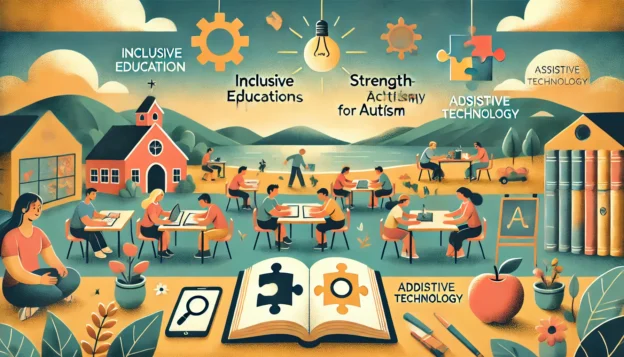This article explores key educational concepts for supporting autistic students, including inclusive education, strength-based approaches, and assistive technology. Inclusive education integrates all students into mainstream classrooms, promoting diversity and equal opportunities, as highlighted by the Salamanca Statement in 1994 (MDPI, 2023). Strength-based approaches focus on leveraging students’ strengths and interests to enhance learning and engagement (Education Hub, 2023). Assistive technology provides tools like text-to-speech and robotics to support individualized learning needs (SpringerLink, 2021; Emerald Insight, 2021). The article discusses how these methods intersect to create comprehensive educational strategies while noting potential divergences. The author advocates for combining these approaches to create supportive and effective learning environments for all students.
Introduction
This article explores key concepts in education and support for autistic individuals, focusing on inclusive education, strength-based approaches, and assistive technology. It provides historical context, describes each concept, and discusses how these approaches complement or differ from each other. The article concludes with a subjective opinion on the implications for educational practices.
Inclusive Education
Inclusive Education aims to integrate all students, including those with disabilities, into mainstream classrooms. The idea gained prominence with the Salamanca Statement in 1994, which emphasized the right of every child to receive education in regular schools. Inclusive education involves adapting teaching methods and classroom environments to accommodate diverse learning needs, promoting equal opportunities for all students. This approach is based on the belief that inclusive settings benefit both neurodivergent and neurotypical students by fostering a culture of diversity and acceptance (MDPI, 2023).
Strength-based Approaches
Strength-based Approaches focus on leveraging the inherent strengths and interests of autistic students to enhance their educational experiences. Instead of emphasizing deficits, this approach aims to build on what students can do well, thereby boosting their confidence and engagement. Strength-based approaches can include personalized learning plans that integrate students’ interests into the curriculum, promoting a positive and supportive learning environment. Research has shown that these methods can significantly improve academic and social outcomes for autistic students (Education Hub, 2023).
Assistive Technology
Assistive Technology (AT) refers to devices and software designed to support the educational needs of students with disabilities. AT can range from simple tools, like text-to-speech applications, to more complex systems, such as robotics for STEM learning. The use of AT in education has been shown to facilitate inclusion by enabling students to participate more fully in classroom activities. Effective use of AT requires careful consideration of the individual needs of students and ongoing assessment to ensure that the technology is enhancing learning experiences (SpringerLink, 2021; Emerald Insight, 2021).
Intersections and Divergences
These three approaches, inclusive education, strength-based approaches, and assistive technology, are interconnected and often used together to create a comprehensive educational strategy. Inclusive education provides the framework, strength-based approaches offer personalized strategies, and assistive technology supplies the tools necessary for implementation. However, there can be divergences in how these methods are applied. For instance, while inclusive education focuses on integration, some critics argue that it may not always address the specific needs of all students. Similarly, assistive technology must be carefully selected to align with strength-based approaches, ensuring it enhances rather than hinders learning (MDPI, 2023; Education Hub, 2023).
Conclusion
In my opinion, the most effective educational strategies for autistic students involve a blend of inclusive education, strength-based approaches, and assistive technology. Inclusive education promotes a culture of acceptance, strength-based approaches build on students’ natural abilities, and assistive technology provides the necessary support to overcome specific challenges. By integrating these approaches, educators can create a more supportive and effective learning environment that caters to the diverse needs of all students.
References
- Creating Inclusive Schools for Autistic Students: A Scoping Review on Elements Contributing to Strengths-Based Approaches. MDPI (2023).
- Assistive Technology to Support Inclusive Education. Emerald Insight (2021).
- From Assistive to Adaptive: Can We Bring a Strengths-Based Approach to Designing Disability Technology? SpringerLink (2021).
- A Strengths-based Approach to Teaching Neurodiverse Learners. Education Hub (2023).
